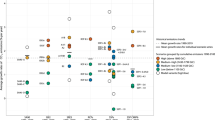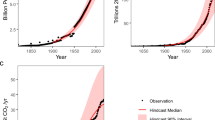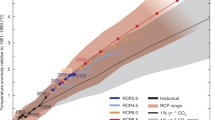Abstract
This article assesses emissions scenarios in the literature, originally documented in the scenario database that was developed more than 7 years ago. The original scenario assessment and literature review has been used, among other things, as the basis for the quantification of the Intergovernmental Panel on Climate Change (IPCC) Special Report on Emissions Scenarios (SRES) reference scenarios and the IPCC Third Assessment Report (TAR) stabilization scenarios. In the meantime, a large number of new emissions scenarios have been developed and published. We have collected the relevant information about these new scenarios with the objective to assess the more recent perspectives about future global emissions and to assess the changes in the perspectives about future emissions and their driving forces that may have occurred since the publication of SRES and TAR scenarios. Our analysis goes beyond mere comparisons of emissions ranges. In particular, we explore the underlying drivers of emissions using the so-called IPAT identity (Impacts are proportional to the product of Population, Affluence, and Technology). When IPAT analysis refers to carbon emissions it is called the Kaya identity, where carbon dioxide (CO2) emissions are assumed to correspond to the product of population, per capita income, energy intensity of gross domestic product (GDP), and CO2 intensity of energy. Comparing the recent scenario literature with the scenarios developed before TAR shows that there are strong similarities for the main underlying tendencies in many of the scenario’s driving forces and results.
Similar content being viewed by others
References
Alcamo J, Bouwman A, Edmonds J, Grübler A, Morita T, Sugandhy A (1995) An evaluation of the IPCC IS92 emission scenarios, IPCG1995, climate change 1994. Cambridge University Press, Cambridge, pp 233–304
Barreto L, Makihira A, Riahi K (2003) The hydrogen economy in the 21st century: a sustainable development scenario. International Journal of Hydrogen Energy 28:267–284
Bos E, Vu MT (1994) World population projections: estimates and projections with related demographic statistics 1994–1995 edition. The World Bank, Washington DC
Demeny P (1990) Population. In: Turner BL II, Clark WC, Kates RW, Richards JF, Mathews JT, Meyer WB (eds) The earth as transformed by human action. Cambridge University Press, Cambridge
Dowlatabadi H, Kandlikar M (1995) Key uncertainties in climate change policy: results from ICAM-2. Proceedings of the Global Warming Conference, San Francisco, US
Durand JD (1967) The modern expansion of world population. Proceedings of the American Philosophical Society 111:136–159
Edenhofer O, Lessmann K, Kemfert C, Grubb M, Koehler J (2006) Induced technological change: exploring its implications for the economics of atmospheric stabilization—synthesis report from the Innovation Modelling Comparison Project (IMCP). Energy (in press)
Ehrlich P, Holdren J (1971) Impact of population growth. Science 171:1212–1217
Holdren J (2000) Environmental degradation: population, affluence, technology, and sociopolitical factors. Environment 42:4–5
Intergovernmental Panel on Climate Change (IPCC) (1990) Climate change: the scientific assessment. Houghton JT, Jenkins GJ, Ephramus JJ (eds) Cambridge University Press, Cambridge
(IPCC) (2005) Meeting report for the Workshop on New Emission Scenarios, 29 June–1 July 2005, Laxenburg, Austria. http://arch.rivm.nl/env/int/ipcc/pages_media/meeting_report_workshop_new_emission_scenarios.pdf. Cited September 2005
IEA (2002) World energy outlook. IEA/OECD, Paris, France
IEA (2003) World energy investment outlook. IEA/OECD, Paris, France
IEA (2004) World energy outlook. IEA/OECD, Paris, France
IIASA-WEC (1995) Global energy perspectives to 2050 and beyond. International Institute for Applied Systems Analysis, Laxenburg, Austria
Kanoh T (1992) Toward dematerialization and decarbonization, in science and sustainability. Selected Papers on IIASA’s 20th Anniversary, IIASA, Laxenburg, Austria
Kemfert C, Truong TP, Bruckner T (2006) Economic impact assessment of climate change—a multigas investigation with WIAGEM-GTAPEL-ICM. Energy Journal (accepted)
Kemp-Benedict E, Heaps C, Raskin P (2002) Global scenario group futures: technical notes. Stockholm Environment Institute-Boston, Boston, MA, USA
Khanna N, Chapman D (2001) Energy efficiency and petroleum depletion in climate change policy. In: Hall DC, Howarth RB (eds) The long-term economics of climate change: beyond a doubling of greenhouse gas concentrations. Elsevier, Amsterdam, pp 239–264
Kurosawa A (2004) Carbon concentration target and technological choice. Energy Economics 26:675–684
Leggett J, Pepper WJ, Swart RJ (1992) Emissions scenarios for the IPCC: an update, IPCC, climate change 1992. Cambridge University Press, Cambridge, pp 69–95
Lutz W, Sanderson W, Scherbov S (1997) Doubling of world population unlikely. Nature 387:803–805
Lutz W, Sanderson W, Scherbov S (2001) The end of world population growth. Nature 412:543–545
Manne A, Richels R (1995) The greenhouse debate—economic efficiency, burden sharing and hedging strategies. Energy Journal 16:1–37
Manne A, Schrattenholzer L (1996) International Energy Workshop January 1996 Poll Edition. IIASA, Laxenburg, Austria
Manne A, Schrattenholzer L (1997) International Energy Workshop, part I: overview of poll responses, part II: frequency distributions, part III: individual poll responses. February 1997, IIASA, Laxenburg, Austria
Marland G, Andres RJ, Boden TA (1994) Global, regional, and national CO2 emissions. In Boden TA, Kaiser DP, Sepanski RJ, Stoss FW (eds) Trends ’93: A Compendium of Data on Global Change. ORNL/CDIAC-65. Oak Ridge, TN: Carbon Dioxide Information Analysis Center, ORNL. 505–584
Mori S (2003) Global warming issues from long term—food supply and energy. Journal of the Japan Institute of Energy 82:25–30
Morita T, Lee H-C (1998) IPCC SRES database, version 0.1, emission scenario database prepared for IPCC Special Report on Emission Scenarios. http://www-cger.nies.go.jp/cger-e/db/ipcc.html. Cited September 2005
Morita T, Robinson J, Adegbulugbe A, Alcamo J, Herbert D, La Rovere EL, Nakicenovic N, Pitcher H, Raskin P, Riahi K, Sankovski A, Sokolov V, Vries HJM, Dadi Z (2001) Greenhouse gas emission mitigation scenarios and implications. In: Metz B, Davidson O, Swart R, Pan J (eds) Climate change 2001: mitigation, contribution of Working Group III to the Third Assessment Report of the Intergovernmental Panel on Climate Change. Cambridge University Press, Cambridge
Nakicenovic N (1996) Freeing energy from carbon. Daedalus 125:95–112
Nakicenovic N, Victor N, Morita T (1998a) Emissions scenarios database and review of scenarios. Mitigation and Adaptation Strategies for Global Change 3:95–120
Nakicenovic N, Grübler A, McDonald A (1998b) Global energy perspectives. Cambridge University Press, Cambridge
Nakicenovic N, Alcamo J, Davis G, de Vries B, Fenhann J et al. (2000) Special report on emissions scenarios (SRES): a special report of Working Group III of the Intergovernmental Panel on Climate Change. Cambridge University Press, Cambridge
O’Neill BC (2005) Population scenarios based on probabilistic projections: an application for the millennium ecosystem assessment. Population and Environment 26:229–254
Peck SC, Teisberg TJ (1995) International CO2 emissions control—an analysis using CETA. Energy Policy 23:297–308
Pepper W, Leggett J, Swart R, Wasson J, Edmonds J, Mintzer I (1992) Emission scenarios for the IPCC, an update, assumptions, methodology, and results. Intergovernmental Panel on Climate Change, Working Group I
Reilly J, Sarofim M, Paltsev S (2006) The role of non-CO2 GHGs in climate policy: analysis using the MIT IGSM. Energy Journal (in press)
Riahi K, Roehrl AR (2000) Greenhouse gas emissions in a dynamics as usual scenario of economic and energy development. Technological Forecasting and Social Change 63:175–205
Roehrl AR, Riahi K (2000) Technology dynamics and greenhouse gas emissions mitigation: a cost assessment. Technological Forecasting and Social Change 63:231–261
United Nations (UN) (1996) Annual populations 1950–2050: the 1996 revision. UN Population Division. United Nations, New York, (data on diskettes)
UN (1998) World population projections to 2150. UN Department of Economic and Social Affairs, Population Division, United Nations, New York
UN (2003) World population prospects: the 2002 revision, vol 3. Analytical report. UN Department of Economic and Social Affairs, Population Division, United Nations, New York
van Vuuren DP, den Elzen MGJ, Berk MM, Lucas P, Eickhout B, Eerens H, Oostenrijk R (2003) Regional costs and benefits of alternative post-Kyoto regimes. RIVM report 728001025, 2003
van Vuuren DP, Weyant J, de la Chesnaye F (2006) Multi-gas Scenarios to Stabilize Radiative Forcing. Energy Economics 28:102–120
Weyant JP (1993) Costs of reducing global carbon emissions. Journal of Economic Perspectives 7:7–46
Weyant JP (2004) Introduction and overview, in EMF 19: alternative technology strategies for climate change policy. Special Issue of Energy Economics 26:501–515
Yamaji K, Matsuhashi R, Nagata Y, Kaya Y (1991) An integrated system for CO2/energy/GNP analysis: case studies on economic measures for CO2 reduction in Japan. Workshop on CO2 Reduction and Removal: Measures for the Next Century, 19–21 March 1991, IIASA, Laxenburg, Austria
Yamaji K, Fujino J, Osada K (2000) Global energy system to maintain atmospheric CO2 concentration at 550ppm. Environmental Economics and Policy Studies 3:159–171
Author information
Authors and Affiliations
About this article
Cite this article
Nakicenovic, N., Kolp, P., Riahi, K. et al. Assessment of emissions scenarios revisited. Environ Econ Policy Stud 7, 137–173 (2006). https://doi.org/10.1007/BF03353998
Received:
Accepted:
Published:
Issue Date:
DOI: https://doi.org/10.1007/BF03353998




